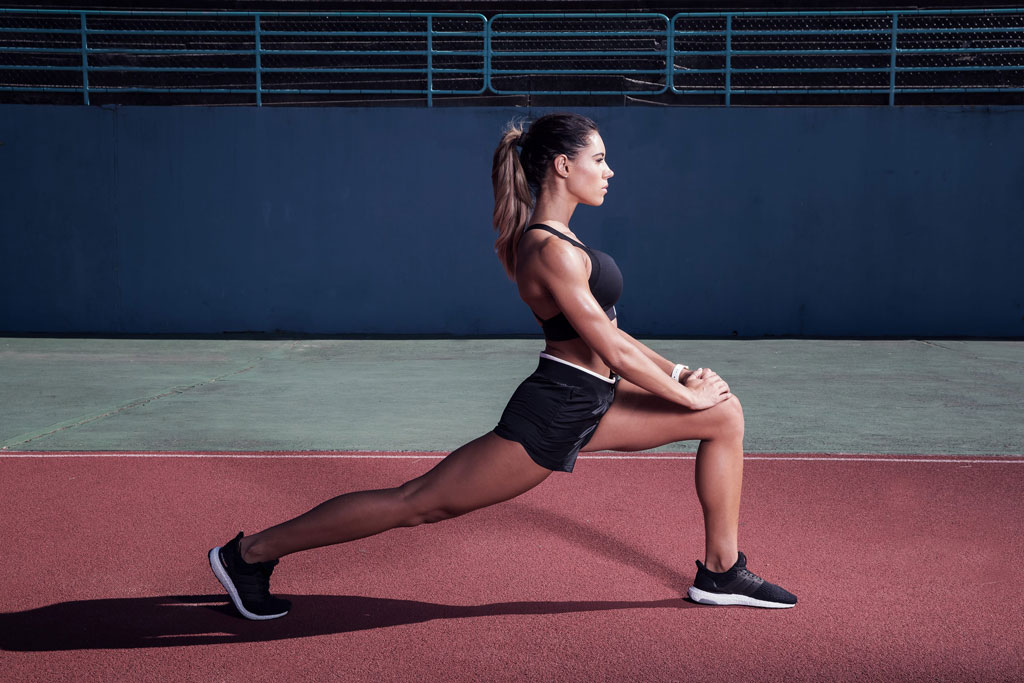If you’ve been training hard, you may have experienced delayed-onset muscle soreness (DOMS) — that crippling muscle ache in the days after a tough workout. While a fitness hangover can cramp your style, you don’t have to suffer if you’ve pushed yourself in your workouts.
Use these tips to recover faster from your training and keep working towards your health goals!
How to speed up muscle recovery
Our trainers often get questions asking how to prevent or reduce muscle soreness following a workout. Here some proven tips to help you get back to training sooner:
Hydrate
Drinking water is essential for post-workout recovery. According to a 2012 article in Sports Medicine, when you’ve completed a high-intensity workout or it’s a hot day, you also need to consider rebalancing your electrolytes.
Electrolytes include minerals like magnesium, potassium, calcium and sodium, and are found in most foods. These minerals are important for your nervous system, and they also get used up during muscle contraction. You can get enough electrolytes for muscle recovery by implementing healthy eating habits and including plenty of fruit and vegetables.
Having a glass of milk or a fruit smoothie after your workout can help replace electrolytes in your blood and aid recovery. If you have a very low-sodium diet, you could also add salt to lemon water in the morning.

Grab a post-workout snack
After a workout, a snack containing both carbohydrate and protein can help you to recover more quickly by providing the nutrients your muscle tissue needs to begin repairing.
You could try a coffee smoothie after a morning workout to start your day, or prepare fruit with yoghurt. The options for quick, healthy snacks are endless — just make sure that you include both protein and some healthy carbohydrate.
If you follow a plant-based diet, eating almonds, tofu, chickpeas and other high-protein foods can give your muscles the nutrients they need to repair.
A high-protein snack in the evening can also aid muscle repair overnight.
Use a workout supplement
Some trainers and athletes use branch-chain amino acids (BCAAs). A 2010 study in the International Journal of Sports Nutrition and Exercise Metabolism showed that women who take a BCAAs supplement before a workout may have less post-workout soreness and shorter muscle recovery time.
For those who already follow a healthy diet, using supplements may not have a noticeable impact. That’s because BCAAs are found in whole foods like eggs, tuna, yoghurt and milk.
Find some post-workout snacks that you really enjoy for optimal recovery, and remember that what you eat before your workout can have an impact on your muscle recovery too!

Warm up before resistance training
Taking five minutes to complete an effective warmup can help to minimise delayed-onset muscle soreness (DOMS) and decrease any risk of injury. A proper warmup is especially important before exercises like deadlifts, pull-ups or single-arm rows. These exercises involve slow eccentric movements, which means that the muscle lengthens but contracts simultaneously.
Use dynamic stretching before your workout to activate the muscles you are about to use. These exercises will gently lengthen and activate the muscles, helping to prevent overstretching, strain or injury during your workout.
Make time to cool down
Taking 5-10 minutes to jog slowly or walk on the treadmill can help your body to cool down, especially if you’ve just completed a tough workout or a HIIT session. Once your heart rate has slowed, static stretching — where you hold a stretch position — can help to improve your range of motion.
Doing a short stretching session before bed may also help you to sleep better.

Foam roll and stretch
A 2019 study in Frontiers of Physiology found that foam rolling before a workout can help to increase performance. You should use dynamic stretches as part of your warmup to prepare the muscles you are going to use in your workout.
For example, doing stretches and activations for your glutes before and after a leg workout can help to improve flexibility and help you to get the most out of your training.
Taking time on rest days to stretch tight hips can help reduce any discomfort and improve flexibility.
Elevate your legs
We spend most of our time with our legs down, whether it’s sitting, standing, walking or running.
Elevating your legs up a wall for 5-10 minutes can help to reduce swelling in the muscles. These calming yoga poses may also help to improve circulation.

Take a cool bath
When you work out you may cause microdamage to your muscles, which can result in swelling, inflammation and soreness. This process is normal, as the muscles are adapting to the workload and becoming stronger!
If you are still sore one or two days after your workout, taking a cool bath could help to reduce inflammation.
For any soreness that lasts more than five days, or if you have a very high level of pain, you should see a health professional.
Don’t skip rest days
There are times when you just need to simply rest. Getting an early night and a good sleep can help to speed up the muscle repair process and leave you feeling refreshed the next day.
With any training program, you should aim to have one full day of rest each week to allow your body to recover and adapt to the work done on the previous training days.

Keep moving
Light movement on your rest days can help to keep the blood circulating throughout your body, bringing nutrients to repair the muscles and assisting with the removal of metabolic waste products. A 2018 review of the literature in Frontiers in Physiology found that active recovery done within the first few days of a tough workout reduced the effects of delayed onset muscle soreness.
When you work out, you cause microtears in the muscle which need time to repair — that’s what rest days are for! Keeping the blood flowing will help to speed up muscle recovery.
Even short sessions of gentle exercise will help — you might take the stairs rather than the elevator or make time for 10 minutes of walking during the day.
Wear compression tights
A 2016 review of the literature in Physiology & Behaviour found that wearing compression garments may aid in the recovery of exercise-induced muscle damage.
Compression clothing may also help to reduce your perception of muscle soreness, and to reduce the inflammation and swelling that cause soreness.
The tightness of the fabric can help to promote blood flow through the deeper blood vessels rather than those on the surface, which may aid with clearing waste and providing nutrients to the muscle fibres.

Reduce stress
It probably won’t surprise you to learn that your emotional and mental wellbeing can affect your muscle recovery.
When you are under stress, the body is focused on the stress response and doesn’t have the capacity to prioritise muscle recovery.
Stress can also affect your sleep, eating patterns and general self-care. All of these things can impact your immune response, which is essential for muscle recovery.
Taking the time to reduce stress in your life using techniques like mindfulness and meditation can benefit your muscle recovery and also improve your overall wellbeing.
Follow the principle of progressive overload
Your training program shouldn’t leave you feeling sore for days on end after each workout. Ideally, any resistance training program will gradually increase the intensity of each workout, within your limits.
By applying this principle, you will continually challenge your body without pushing it beyond its current threshold. An important part of progressive overload is selecting the right weights and number of reps for each exercise.
Listen to your body
Sometimes after a workout one side of your body might feel tighter than the other. These imbalances can occur as a result of our lifestyle and habits.
For example, if you are right or left-handed, one side will usually be stronger than the other. The weaker side may get tighter when you work out.
Take a moment after your workout to breathe and focus on how your body feels — then you can tailor your cool down to what your body needs that day.
You might spend a little extra time stretching one area that’s tight and pay some attention to how it feels during your next workout.
Use these muscle recovery ideas to bounce back after your next workout!
Being sore isn’t necessarily a sign of a good workout. However, when you first start a new workout program, muscle soreness is very common.
If you make some of these changes to your routine and you still find that you get sore more than most people, you should consider speaking with a healthcare professional.


